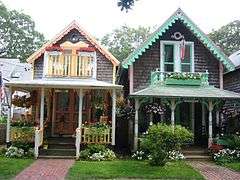Wesleyan Grove
|
Wesleyan Grove | |
|
Two ornate cottages on the campground site. | |
  | |
| Location | 80 Trinity Park, Oak Bluffs, MA 02557 |
|---|---|
| NRHP Reference # | 05000458 |
| Significant dates | |
| Added to NRHP | April 5, 2005[1] |
| Designated NHLD | April 5, 2005[2] |
|
Martha's Vineyard Campground | |
  | |
| Location | Roughly bounded by Cottage Park, Quequechan, Clinton, Dukes, County, Siloam, Lake, and Central Aves., Oak Bluffs, Massachusetts |
|---|---|
| Coordinates | 41°27′19″N 70°33′41″W / 41.45528°N 70.56139°WCoordinates: 41°27′19″N 70°33′41″W / 41.45528°N 70.56139°W |
| Built | 1835 |
| Architect | Multiple |
| Architectural style | Late Gothic Revival, Gothic, Gothic Revival |
| NRHP Reference # | 78000439 |
| Added to NRHP | December 14, 1978[1] |

Wesleyan Grove is a 34-acre (14 ha) National Historic Landmark District in Oak Bluffs, Massachusetts on the island of Martha's Vineyard. Also known as the Martha's Vineyard Campmeeting Association (MVCMA) or the Campgrounds, it was the first summer religious camp established in the United States. It is famous for its many Carpenter Gothic[3] cottages with Victorian-style, gingerbread trim.[4]
History
Just after the American Civil War, the area developed as a large Methodist summer campground with open air Christian revivals. This meeting style became popular around the United States at the time, and many other similar camps were founded using similar models, such as Ocean Park, Maine and Ocean Grove, New Jersey. Colorful, ornate, gingerbread cottages were built in an oak grove around a central church tabernacle. The grove was added to the National Register of Historic Places in 1978 and was further declared a National Historic Landmark in 2005.[2][1]
The first so-called campmeeting in what became known as Wesleyan Grove was held in 1835. In subsequent years the congregations grew enormously, and many of the thousands in attendance were housed in large tents known as "society tents." A congregation from a church on the mainland would maintain its own society tent. Conditions were cramped, with men and women sleeping dormitory-style on opposite sides of a central canvas divider. Society tents were arranged in a semicircle on Trinity Park. Over time, families began leasing small lots on which to pitch their own individual tents. Between 1855 and 1865 the campmeetings began to change in character. They continued to be religious in nature, but the participants also began to enjoy the benefit of the sea air and social interaction as they revived both mind and body.[5]
In the 1860s and 1870s, the family tents were rapidly replaced with permanent wooden cottages. At one time there were about 500 cottages; today there are just 318[5] and are referred to as the gingerbread cottages.
Many eminent members of the clergy from across the country have preached at the campmeetings in Wesleyan Grove. That tradition continues today, although services are no longer held day and night as they were in the early years. Over time the MVCMA has become increasingly interdenominational, and the current members of the Board of Directors are affiliated with a wide variety of religious groups. The religious services and special programs of the Association all have a strong ecumenical spirit. Whereas the MVCMA was established by Methodists, and, for much of its history, was governed exclusively by Methodists, it has always been an autonomous organization and was never formally affiliated with the New England Conference of the United Methodist Church.[5]
Today the Campground is a community of summer residents and a smaller number of year-round residents who value the intimacy created by the crowding of cottages on small tent lots. Many of the cottages have been owned by the same families for generations. The residents of the Campground have a keen appreciation for the special traditions of which they are a part.

The Tabernacle is the physical and spiritual center of the Campground. It was built in 1879 by John W. Hoyt of Springfield, Massachusetts. Church services are held weekly in the Tabernacle during the months of July and August, and a variety of cultural events are held there each summer. The first event of the season is the graduation ceremonies of the Martha's Vineyard Regional High School. Architecturally, the Tabernacle is a unique structure, with wrought iron arches and supports, two clerestories with dozens of colored glass windows, and an octagonal cupola. In 1979, on the Centennial of the Tabernacle, the MVCMA was added to the National Register of Historic Places. In 2000, the Tabernacle was designated as an official project of "Save America's Treasures." From the first camp meeting in 1835 until 1859, ministers preached from a crudely constructed stand. In 1859, Perez Mason built a larger and more esthetically pleasing preachers' stand. It was large enough to seat 30, and it included lattice screen supports, movable rear shutters for ventilation, and a roof that was angled to amplify the voice of the speaker. Seating for congregations of up to 4,000 was constructed during that period. In 1869, a huge tent was raised over Wesleyan Grove to protect the congregation from the heat and the rain. The tent was used each season until the erection of the current iron Tabernacle in 1879. In 1999 a major fundraising campaign was undertaken to restore the Tabernacle to its full grandeur, to upgrade utilities, including sound and lighting systems, and to preserve the structural integrity of the building.
See also
- List of National Historic Landmarks in Massachusetts
- National Register of Historic Places listings in Dukes County, Massachusetts
References
- 1 2 3 National Park Service (2008-04-15). "National Register Information System". National Register of Historic Places. National Park Service.
- 1 2 "Wesleyan Grove". National Historic Landmark summary listing. National Park Service. Retrieved 2008-09-13.
- ↑ Carpenter Gothic
- ↑ http://homeguides.sfgate.com/decorate-victorian-houses-gingerbread-trim-patterns-61344.html
- 1 2 3 http://www.mvcma.org/history/brief-history-of-mvcma/

